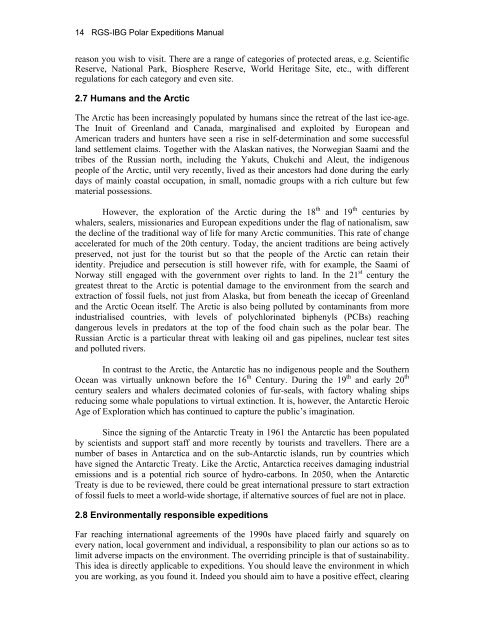Edited by Rachel Duncan 4th Edition ISBN 0-907649-91-2 London ...
Edited by Rachel Duncan 4th Edition ISBN 0-907649-91-2 London ...
Edited by Rachel Duncan 4th Edition ISBN 0-907649-91-2 London ...
You also want an ePaper? Increase the reach of your titles
YUMPU automatically turns print PDFs into web optimized ePapers that Google loves.
14 RGS-IBG Polar Expeditions Manual<br />
reason you wish to visit. There are a range of categories of protected areas, e.g. Scientific<br />
Reserve, National Park, Biosphere Reserve, World Heritage Site, etc., with different<br />
regulations for each category and even site.<br />
2.7 Humans and the Arctic<br />
The Arctic has been increasingly populated <strong>by</strong> humans since the retreat of the last ice-age.<br />
The Inuit of Greenland and Canada, marginalised and exploited <strong>by</strong> European and<br />
American traders and hunters have seen a rise in self-determination and some successful<br />
land settlement claims. Together with the Alaskan natives, the Norwegian Saami and the<br />
tribes of the Russian north, including the Yakuts, Chukchi and Aleut, the indigenous<br />
people of the Arctic, until very recently, lived as their ancestors had done during the early<br />
days of mainly coastal occupation, in small, nomadic groups with a rich culture but few<br />
material possessions.<br />
However, the exploration of the Arctic during the 18 th and 19 th centuries <strong>by</strong><br />
whalers, sealers, missionaries and European expeditions under the flag of nationalism, saw<br />
the decline of the traditional way of life for many Arctic communities. This rate of change<br />
accelerated for much of the 20th century. Today, the ancient traditions are being actively<br />
preserved, not just for the tourist but so that the people of the Arctic can retain their<br />
identity. Prejudice and persecution is still however rife, with for example, the Saami of<br />
Norway still engaged with the government over rights to land. In the 21 st century the<br />
greatest threat to the Arctic is potential damage to the environment from the search and<br />
extraction of fossil fuels, not just from Alaska, but from beneath the icecap of Greenland<br />
and the Arctic Ocean itself. The Arctic is also being polluted <strong>by</strong> contaminants from more<br />
industrialised countries, with levels of polychlorinated biphenyls (PCBs) reaching<br />
dangerous levels in predators at the top of the food chain such as the polar bear. The<br />
Russian Arctic is a particular threat with leaking oil and gas pipelines, nuclear test sites<br />
and polluted rivers.<br />
In contrast to the Arctic, the Antarctic has no indigenous people and the Southern<br />
Ocean was virtually unknown before the 16 th Century. During the 19 th and early 20 th<br />
century sealers and whalers decimated colonies of fur-seals, with factory whaling ships<br />
reducing some whale populations to virtual extinction. It is, however, the Antarctic Heroic<br />
Age of Exploration which has continued to capture the public’s imagination.<br />
Since the signing of the Antarctic Treaty in 1961 the Antarctic has been populated<br />
<strong>by</strong> scientists and support staff and more recently <strong>by</strong> tourists and travellers. There are a<br />
number of bases in Antarctica and on the sub-Antarctic islands, run <strong>by</strong> countries which<br />
have signed the Antarctic Treaty. Like the Arctic, Antarctica receives damaging industrial<br />
emissions and is a potential rich source of hydro-carbons. In 2050, when the Antarctic<br />
Treaty is due to be reviewed, there could be great international pressure to start extraction<br />
of fossil fuels to meet a world-wide shortage, if alternative sources of fuel are not in place.<br />
2.8 Environmentally responsible expeditions<br />
Far reaching international agreements of the 1990s have placed fairly and squarely on<br />
every nation, local government and individual, a responsibility to plan our actions so as to<br />
limit adverse impacts on the environment. The overriding principle is that of sustainability.<br />
This idea is directly applicable to expeditions. You should leave the environment in which<br />
you are working, as you found it. Indeed you should aim to have a positive effect, clearing

















